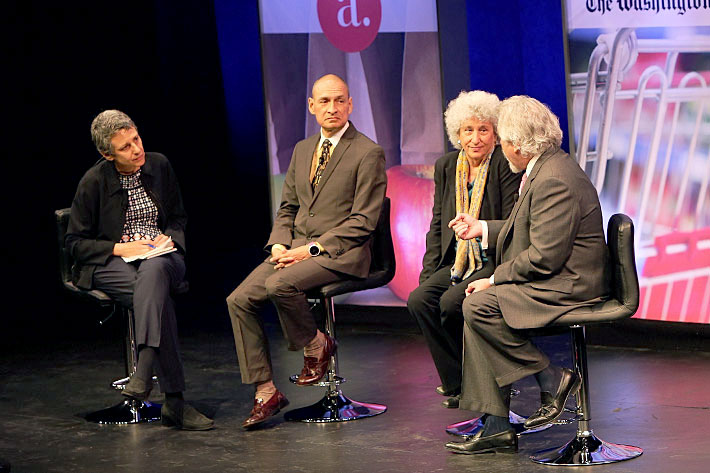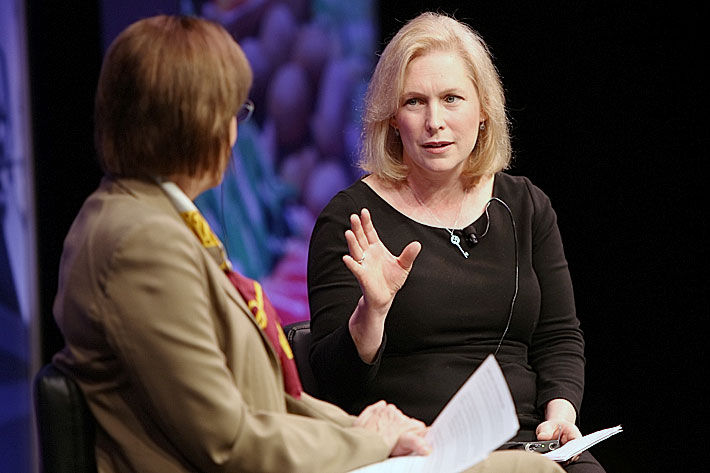From the battle over healthy school lunches and conflict over changing dietary guidelines to regulating agribusiness and combatting food deserts—the problems of the U.S. food system form a complex web.
However, the solution to those problems—offered by policymakers, experts and industry leaders who attended The Washington Post’s America Answers forum Thursday—is simple: teach consumers to demand quality and “vote with their forks.”
“When you go into a supermarket and try to eat healthy, you are fighting against an entire system that you’re probably not aware of,” said author and nutritionist Marion Nestle. “I want food policy that’s linked to health policy…you have to vote with your fork and vote with your vote.”
Dr. Nestle’s call to consumers to transform the food system was the rallying cry throughout the “Changing the Menu” event, a series of discussions punctuated by interactive segments including a live demonstration of a sheep butchering by author and butcher Adam Danforth.
Other notable speakers included AOL founder Steve Case, FEED Projects founder and CEO Lauren Bush Lauren and chef and restaurateur Spike Mendelsohn.
During the "Why Do We Eat the Way We Do?" panel, Ms. Haspel spoke with Ms. Nestle, Phil Lempert,author and editor of The Lempert Report, and Ricardo Salvador, director of the Food and Environment Program at the Union of Concerned Scientists, about the ways the coorporations, government and customers interact in the food system. (Rob Stewart/GW Today)
Kathleen Merrigan—executive director of the sustainability collaborative at the George Washington University—discussed the rapid growth of the organic industry in the United States since the passing of the Organic Food and Production Act in the 1990 Farm Bill.
She will give a lecture Wednesday on the National Organic Program at GW for the First Chapter freshman reading program.
“There has been a renaissance of interest in agriculture that can only lead to good things,” Dr. Merrigan said.
That interest—credited in part to the food movement and millennial passion by Dr. Nestle, Dr. Merrigan and other speakers—has resulted in slow-moving but effective policy.
Senators Debbie Stabenow (D-Mich.) and Kirsten Gillibrand (D-N.Y.) and Secretary of Agriculture Tom Vilsack represented the policy arm of the food system, offering insight into the difficulties of designing policy that supports perspectives of corporate America, health experts and U.S. citizens.
Sen. Stabenow boasted about the potential nationwide expansion of Michigan’s “Double Up Food Bucks” program. The Supplemental Nutritional Assistance Program (SNAP) initiative doubles the value of food dollars spent at farmers markets and participating grocery stores.
But she also reminded the audience that fruits and vegetables didn’t get a chapter in the Farm Bill until 2008—nearly 30 years after the first bill was drafted.
“It was a huge fight,” Sen. Stabenow said.
Sec. Vilsack also was temperate in his praise of food policy, but noted that SNAP participation has reached more than 80 percent nationwide—the highest rate of participation to date among communities that need assistance.
Sen. Gillibrand—who did not vote for the 2015 reauthorization of the Farm Bill—was perhaps the most caustic in her assessment of Congress’s support for sound nutrition policy. She said that cuts to food stamp assistance in the bill were “unacceptable.”

Sen. Kirsten Gillibrand (D-N.Y.) told Washington Post National Political Correspondent Karen Tumulty that encourage a healthy diet, she challenges her two children to build a colorful plate at mealtime to earn "points." "My son said to me, 'Mom! There's no blue!,' because we didn't have blueberries," she laughed. (Rob Stewart/GW Today)
“Most food insecure families are starving for nutrition,” Sen. Gillibrand said before receiving wide applause for her commitment to be “aggressive” with her colleagues in Congress on future legislation. “Advocacy against nutritional standards is coming from companies that benefit from serving the lowest quality food,” she added.
From the perspective of Donnie Smith, CEO of Tyson’s Food—the third largest U.S. meat producer—changing food quality and product design is a result of market demand, not policy.
Mr. Smith said he welcomes the discussion about the nutritional value of meat consumption, a topic that has been in the spotlight since the USDA Dietary Guidelines Committee suggested limited consumption of meat for a healthy diet.
“Tyson’s is moving toward the consumer,” Mr. Smith said. “If the consumer says they want a cleaner label for lunchmeat, or more organic options, we will move in that direction.”
Washington Post columnist Tamar Haspel agreed that consumer power was an effective tool in changing the food industry. She moderated two discussions, including “Meat in the Middle” with Nicolette Hahn Niman, a rancher and author of “Defending Beef,” Barry Carpenter, president and chief executive of the North American Meat Institute, and Mr. Danforth.
“Essentially, we have the food system we deserve,” Ms. Haspel said.
Buoyed by federal funding and the ethos expressed by Ms. Haspel, some school districts are taking more responsibility for school nutrition.
In schools located in Richmond, Va., where 40 percent of minors live below the poverty line, all public school students are eligible for free lunch and breakfast with food options such as fruits, vegetables and lean meats.
According to Richmond Public Schools Superintendent Dana Bedden and First Lady of the Commonwealth of Virginia Dorothy McAuliffe, the success of this initiative is the result of testing what students need and want in their meals.
“It’s not about quantity vs. quality—it has to be both,” Ms. McAuliffe said.


